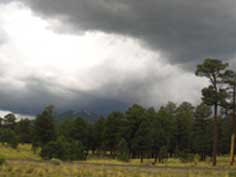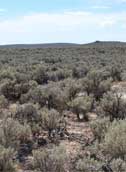Basic:


Weather
Changing weather patterns represent the most obvious impact of climate change and could pose serious challenges to societies confronting a shifting climate.
Weather affects all aspects of natural and anthropogenic systems, from old-growth forests to agriculture, transportation,
industry, and human health. As weather patterns change in response to a warming climate, humans may be forced to alter
the lifeways that have sustained them for centuries. Growing seasons and animal migration patterns may change. Water
quality and availability could be adversely impacted in some communities, especially those with few sources of potable
water.
Weather and climate are closely interconnected, but there are important differences. Weather is the condition of the
atmosphere during a given, short-term interval, like days, weeks, or even months at a specific location. It measures
such things as temperature, humidity, wind, and precipitation. Climate describes the average weather over space and time.
As anyone who has witnessed a warm, sunny day turn cold and overcast recognizes, weather can change over the course of
several hours, or even minutes. Climate describes the statistical change in this natural variability. Earth will probably
always experience periods of hot and cold, although their frequency and intensity will change as the climate shifts.
As the scientists working as part of the Intergovernmental Panel on Climate Change note, "when weather is averaged
over space and time, that fact that the globe is warming emerges clearly from the data." i
 At least initially, Earth will experience only small, incremental changes in weather variables such as temperature and
precipitation. Yet small changes input into the larger atmospheric system will result in larger changes in their extremes.
Over time, conditions that are considered "extremes," ii like heat waves, droughts, and intense storms,
will become more frequent.
At least initially, Earth will experience only small, incremental changes in weather variables such as temperature and
precipitation. Yet small changes input into the larger atmospheric system will result in larger changes in their extremes.
Over time, conditions that are considered "extremes," ii like heat waves, droughts, and intense storms,
will become more frequent.
In North America, six of the last ten years have fallen in the hottest 10% of all years on record for the US, with 2005
being the hottest year ever recorded. At the same time, the country has experienced fewer cold periods and the number of
frost days is expected to decrease. According to a report released by the Rocky Mountain Climate Organization, the West
has warmed 70% more than the rest of the continuous United States;iii it is only surpassed by temperature increases in
Alaska.
The impacts of rising temperatures are diverse and will affect every part of the country. Higher temperatures mean that
Arctic sea ice will continue to thaw and oceans will rise. Continuing temperature elevation will cause coral bleaching
and death, a keystone species in tropical ecosystems. Snowpack is melting earlier and glaciers are disappearing. Pest
infestations are expanding their ranges and causing massive tree-die. Most pests, like the bark beetle and gypsy moth,
have historically been kept in check by winter cold snaps. As winters become milder, insects are able to live through
the season and cause serious forest impacts.
Changes in weather, and in effect climate, are not limited to rising temperatures. Intense periods of rain and snow have
occurred more often in recent decades, especially in eastern North America. The frequency of tropical storms, hurricanes,
and other storms seems to have increased, although the data necessitate further analysis. Scientists project that
precipitation is likely to become less frequent, but more intense-and more dangerous-than in the past.
While the exact impacts of climate change are difficult to quantify, one thing is for certain: the world is warming, and
that warming stems from humans. Alaskan coastal villages-most inhabited by Native Alaskans who have contributed little
to the crisis-are already feeling the heat. The United Kingdom's Guardian Newspaper tells this story, of global climage
change's first refugees.iv The Yup'ik Eskimos have inhabited a tiny village called Newtok on Alaska's southwestern tip
for the last 2,000 years. They livelihoods changed little over the years, subsisting primarily by hunting and foraging
wild berries on the sparse tundra that surrounds them. Yet their small village is little literally disappearing. According
to NASA, Arctic temperatures have risen 4 degree Fahrenheit on average over the last 50 years, and up to 10 degrees
higher in winter-more than double the warming rate in the rest of the world. Higher temperatures have caused the permafrost
to melt, which has saturated the ground with water. Buildings are sinking into the soggy Earth. Without the ice to hold
back the sea, the land is crumbling into the ocean at rates up to 90 feet per year. The erosion is particularly bad
during the summer storms-- which too have become harsher. Villagers are scrambling to construct their new home on a
small island far above sea level before their home vanishes completely.
In the lower 48 states, global warming may hit the American West the hardest. Communities, already challenged by water
availability, will most likely be forced to deal with lengthening periods of hot, intense drought. The Southwest has been
in a persistent drought since 1996; the event has been the most extreme in the Colorado River Basin.v
Pinyon-juniper woodlands, stressed by drought conditions and bark beetle infestations, are undergoing an unprecedented
die-off event. Drier conditions also lead to wildfires; the area burned has increased 6.7 times in recent years. In
Montana, rising temperatures and changes in stream runoff have caused a fishing shutdown in eight out of the last ten
years.vi
Scientists have well-established that weather patterns are changing and the world will experience extreme weather events
with greater frequency and intensity. The social and economic impacts of these changes will depend on how individuals and,
more importantly, governments, respond today.
For more information about climate and weather, visit the following web resources:
Intergovernmental Panel on Climate Change. 2007. Historical Overview of Climate Change Science in
Working Group I Report, The Physical Science Basis.
www.ipcc.ch/publications_and_data/ar4/wg1/en/contents.html.
US Climate Change Science Program. 2008. Why Weather and Climate Extremes Matter in
Weather and Climate Extremes in a Changing Climate. Regions of Focus: North America, Hawaii, Caribbean, and U.S. Pacific Islands.
www.climatescience.gov/Library/sap/sap3-3/final-report/default.htm#chapters